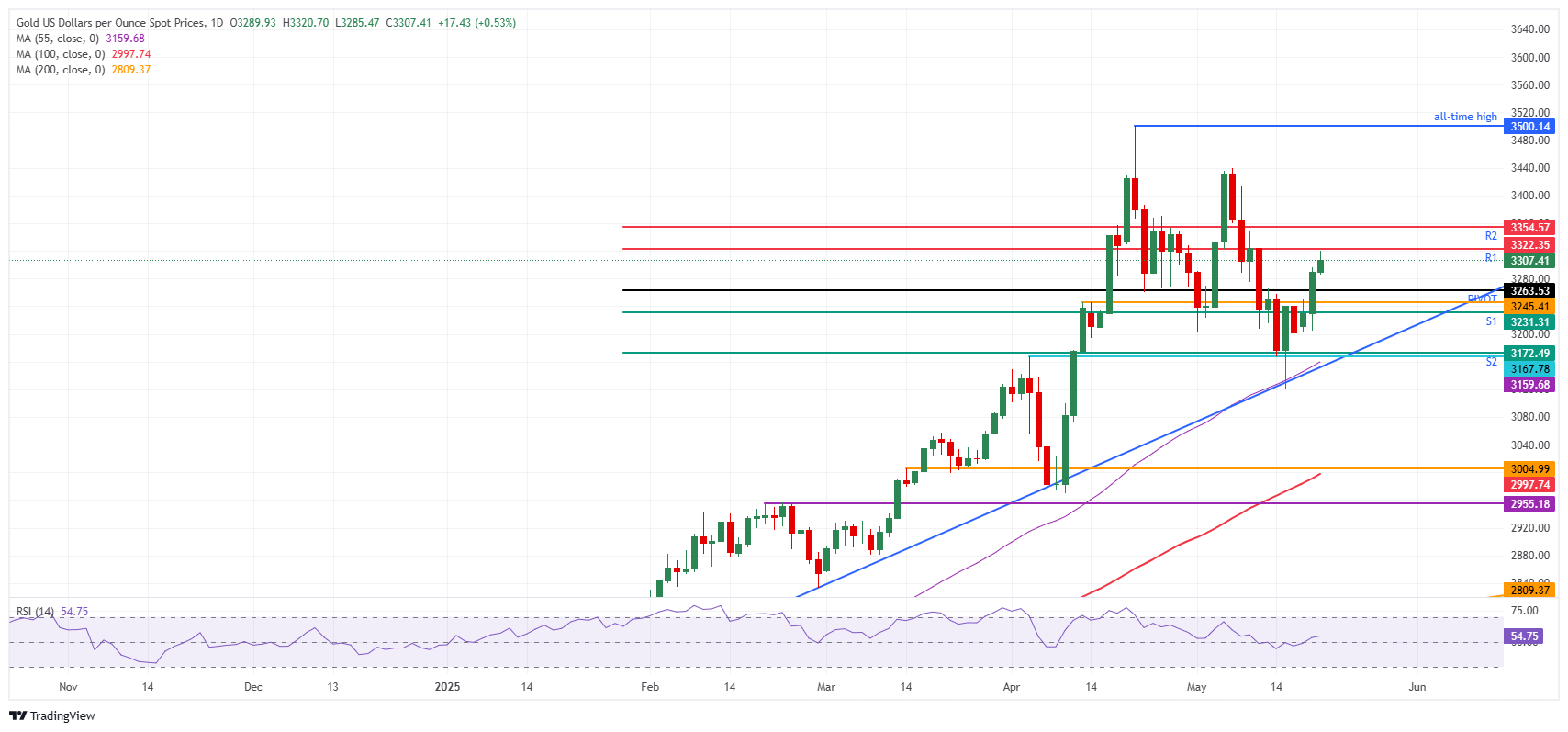Gold edges higher, reclaiming $3,300, on rising geopolitical tensions and US fiscal woes
- Gold price rallies on the back of headlines that Israel considers striking Iran nuclear facilities.
- President Trump clashes with Republican members on getting his fiscal package plan through US Congress.
- Technically, Gold has broken out of its tight range after popping above $3,300.
Gold (XAU/USD) breaks higher on Wednesday towards $3,308 at the time of writing, fueled by concerns that tensions in the Middle East might spiral out of control again and US fiscal woes. In late trading on Tuesday, CNN reported that Israel is considering targeting nuclear sites in Iran. While former United States (US) President Joe Biden was able to change Israel’s Prime Minister Benjamin Netanyahu’s mind, US President Donald Trump has seen his diplomatic efforts fall apart, with markets mulling whether Trump is still able to control Netanyahu.
In the US, President Trump is facing setbacks at home as well as the administration struggles to get enough support to pass through Congress its tax bil. Frustration arose for Trump at Capitol Hill when speaking with lawmakers who demanded to significantly boost the cap on the state and local tax (SALT) deduction.
Daily digest market movers: Awaiting confirmation from Trump or Netanyahu
- Safe-haven support for Gold was boosted by a CNN report that indicated Israel may be planning a strike on Iranian nuclear facilities. It remains unclear whether a final decision to carry out the attack was made, the report said. Markets will want to look for confirmation from either US or Israel’s leaders.
- On the back of the phone call between US President Trump and Russian President Vladimir Putin, the Vatican has proposed to host any event related to Ukraine-Russia peace talks.
- The Financial Times reports that US lawmakers are pressing Northern Ireland to approve an American-owned Gold mine potentially worth billions of pounds to the local economy, warning that delays to the project risk driving away foreign capital.
Gold Price Technical Analysis: Losing grip
Recent headlines about the Middle East and the deadlock in the US Congress are another hit for President Trump and his credibility, and to a broader extent, the credibility of the US Dollar and the US economy. Gold benefits from uncertainty, and it could peak back above $3,350 should Israel confirm its plans.
On the upside, the R1 resistance at $3,324 is the first level to look out for as it aligns with the high of May 12. The R2 resistance at $3,354 follows not far behind the R1 and could open the door for a return to $3,431, which were the peaks of April 21 and May 6 and 7.
Some thick-layered support emerges on the downside in case Gold price declines. On the downside, the daily pivot comes in at $3,263. Next, there is a technical pivotal level at $3,245, and, just below, $3,231 as the intraday S1.

XAU/USD: Daily Chart
Gold FAQs
Gold has played a key role in human’s history as it has been widely used as a store of value and medium of exchange. Currently, apart from its shine and usage for jewelry, the precious metal is widely seen as a safe-haven asset, meaning that it is considered a good investment during turbulent times. Gold is also widely seen as a hedge against inflation and against depreciating currencies as it doesn’t rely on any specific issuer or government.
Central banks are the biggest Gold holders. In their aim to support their currencies in turbulent times, central banks tend to diversify their reserves and buy Gold to improve the perceived strength of the economy and the currency. High Gold reserves can be a source of trust for a country’s solvency. Central banks added 1,136 tonnes of Gold worth around $70 billion to their reserves in 2022, according to data from the World Gold Council. This is the highest yearly purchase since records began. Central banks from emerging economies such as China, India and Turkey are quickly increasing their Gold reserves.
Gold has an inverse correlation with the US Dollar and US Treasuries, which are both major reserve and safe-haven assets. When the Dollar depreciates, Gold tends to rise, enabling investors and central banks to diversify their assets in turbulent times. Gold is also inversely correlated with risk assets. A rally in the stock market tends to weaken Gold price, while sell-offs in riskier markets tend to favor the precious metal.
The price can move due to a wide range of factors. Geopolitical instability or fears of a deep recession can quickly make Gold price escalate due to its safe-haven status. As a yield-less asset, Gold tends to rise with lower interest rates, while higher cost of money usually weighs down on the yellow metal. Still, most moves depend on how the US Dollar (USD) behaves as the asset is priced in dollars (XAU/USD). A strong Dollar tends to keep the price of Gold controlled, whereas a weaker Dollar is likely to push Gold prices up.

